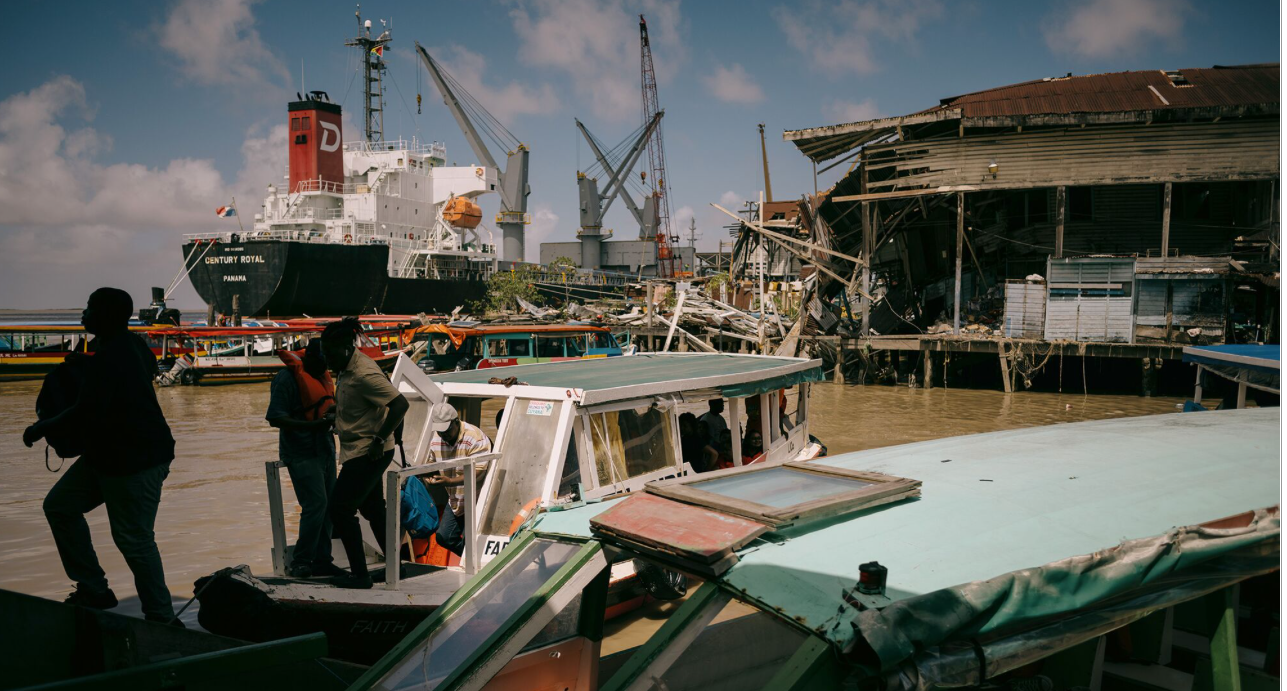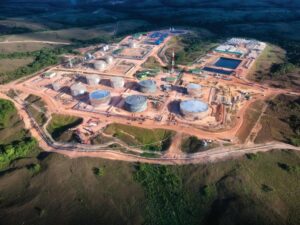
(Bloomberg, 15.Feb.2024) — Guyana has undergone a huge transformation in the near decade since a massive oil discovery off its shores. That’s on full display at the Georgetown Marriott hotel.
By sundown, oil executives in branded shirts step out of vans and mingle with tables of development bank officials, already debriefing over yucca balls and iced beers. A basic room at the chronically sold-out hotel can cost more than $600 on an average night in January. Those prices nearly tripled by the time Guyana’s annual oil conference starts in mid-February, drawing in big energy CEOs and world leaders to the tiny nation of 800,000.
The arrival of the “Marriott crew” is a sign of the change that’s swept the country since Exxon Mobil Corp. struck oil in its waters in 2015. New wells pump out 645,000 barrels everyday, which resulted in $1.6 billion in revenue for Guyana’s government in 2023. The nation’s economy quadrupled in size over the last five years, going from one of the lowest performing in the region to the fastest growing in the world for two years straight. The oil deposits are so large relative to Guyana’s population that some projections show it overtaking Kuwait to become the world’s largest per-capita crude producer, accounting for 16% of net growth in oil supply through 2028.
The blind optimism whispered within the hotel’s walls, however, is loudly challenged once you step outside.
Guyana’s seat of government looms over tarp-covered stalls at the Stabroek Market in Georgetown.
“I have not seen it yet, less tasted it,” 55-year-old Corwin Wright said of his nation’s newfound wealth. He sells bucket hats and baseball caps at the nearby Stabroek market, where hundreds of vendors under tarp-covered stalls fight for the attention of passersby in hopes to hawk anything from mangoes and sugar cane juice to freshly caught pacu fish.
On a rare good day, Wright makes $50, which “is enough to pay bills,” he said, “but no more.”
Can Oil-Rich Guyana Avoid the Resource Curse?
The oil discovery has by and large been a boon for Guyana, a country tucked between Venezuela and Suriname on South America’s north Atlantic coast. But the former British colony must navigate a path forward that avoids the resource curse that’s plagued petrostates that rely too heavily on unpredictable and finite natural resources while abandoning other areas of the economy.
Newly created jobs in the energy sector are benefitting some of Guyana’s population, but many — like Wright — are suffering under rising living prices and still meager wages. And costs have indeed jumped: The country’s annual inflation rate was 0.8% in 2016, according to World Bank figures. But the latest estimate, according to the US State Department, pegs the rate at 6.6% in 2023.
It all presents an outsized challenge for President Irfaan Ali, whose pledge to produce sustainable growth and equitable gains for investors and citizens alike will require deep structural changes in transparency and accountability. Not to mention, threats of interstate conflict have sprouted with Venezuela expanding its military presence on the border. While Ali has been adamant that oil exploration will continue on schedule regardless, the potential for forced arbitration and any following settlement should Venezuela push forward could add costly years to the nations and producers.
On a good day, Wright makes just $50 selling his wares at the Stabroek Market.
“We’ve had this sea change and a massive windfall, but for an economy to change trajectory is not an easy thing,” said University of Guyana economics professor Thomas Singh. “We need leadership that acknowledges that this is a difficult society and there are cleavages that can’t be eliminated just by government spending.”
In hopes of escaping the resource curse, the government created a fund to finance the construction of bridges, highways and schools, and provide subsidies for under-privileged groups. However, it’s already raising governance questions, with the government seeking to increase withdrawals. Current plans for Guyana’s oil wealth distribution are likely to worsen deeply rooted ethnic and political divides, with its Indo-Guyanese population already overrepresented among the top 10% of earners, compared to lower-earning Afro and mixed-Guyanese groups, according to a recent World Development journal report.
“There’s a minefield of things that could go wrong,” Singh said.
Guyana’s annual inflation rate was projected at 6.6% in 2023, according to the US State Department.
Guyana’s Stabroek Block, home to the world’s largest crude discovery of the past decade, is one of the fastest-growing, lowest-cost oil developments outside of Organization of the Petroleum Exporting Countries. Three newly approved fields are expected to start pumping oil in the next three years. By 2028, Exxon forecasts production will double to 1.2 million barrels a day.
Against this backdrop, unemployment rates have declined and lending to the private sector has multiplied.
The impact is visible and felt upon arrival. Banners for oil and gas training services to supply chain logistics and recruitment hang high over a long line of visitors snaking through the immigration line at Georgetown’s airport. Others highlight work on a new four-lane highway funded by the Inter-American Development Bank that’s set to replace the bumpy, poorly lit road that currently carries travelers into the city.
Local companies are struggling to meet the demands of the nation’s infrastructure projects and are relying on foreign firms to complete work.
China is helping Guyana build a new bridge connecting the east and west banks of the Demerara River.
Signs in English and Chinese are posted outside the onshore base for a new bridge over the Demerara River. The project, a joint venture between Guyana and China Railway Construction Corporation, will replace an existing two-lane crossing built in the 1960s, adding two lanes and 24-hour crossing for large boats and the thousands of cars driving in and out of Guyana’s two largest cities. It’s on track to be completed by the end of the year.
Local companies don’t have the capacity to meet these massive projects’ demands, which is why many have been awarded to foreign companies with some requirements to hire local staff. Still, the joint ventures give the Guyanese private sector the opportunity to learn and cooperate with large international partners, said Wazim Mowla, associate director for the Caribbean Initiative at the Atlantic Council.
The country is now a key production zone for Exxon and a major reason why its stock has outperformed peers in the post-pandemic era. On a billboard near its Georgetown headquarters, Exxon says it’s employed nearly 6,000 Guyanese workers, yet the estimated impact through contractors and related industries is far bigger.
Delroy McLean, 28, says the impact of the new jobs has been “life changing.”
He grew up caulking and painting the hulls of boats that would dock on the wharf of Homes Stelling, a small neighborhood of wooden shacks over muddy soil by central Georgetown’s poorest area, known as Tigers Bay. Now, Exxon contractor Saipem SpA built a yard less than 20 feet from McLean’s childhood home, where he has been able to train and work as a crane operator.
McLean trained as a crane operator at the Saipem construction yard, which he credits as a “life changing” opportunity.
“I’m in a better position to help my family, to help myself,” said McLean, who was able to apply for a home loan through a government program last year and is now living in a rental unit in a better area of town. “I can save, I can pay my bills, and still have a small something to take my family to the park or the movies.”
Unemployment skyrocketed in Guyana during the Covid pandemic, which led President Ali to successfully campaign on the promise to create 50,000 jobs by 2025. The jobless rate has trended down since but still holds around 12.4%, with men participating in the labor force at double the rate of women, and with about 40,000 Guyanese people working in the public sector.
A lack of jobs, educational opportunities and livable wages means that about half of the nation’s population lives abroad. Sebastian de Freitas, 33, had left the country to study civil engineering in Brazil when he was offered a lucrative position back in his hometown of Georgetown.
“It’s a bit of planning and also a bit of right place, right time,” said de Freitas, who has spent years training to move up in his role as an ROV pilot from inside an offshore platform. “The Guyanese are not tailored for the oil and gas industry, but we have transferable skills, we have hard workers. You just have to be willing to work to learn to do it.”
Tiffany Balgobin, 22, assistant instructor and safety diver at 3t EnerMech, echoed the sentiment.
“There are more opportunities and more companies coming in and they need people to hire,” she said. “They need to hire local people rather than have people brought in.”
The pandemic employment bust led to scores of Guyanese seeking opportunity outside the country, but the president is promising to bring back 50,000 jobs by 2025.
Construction is booming across Georgetown, developing a new look that will exist side-by-side with the colonial architecture of the past.
The government has launched a series of training and apprenticeship opportunities, including a $100 million investment in a first-ever oil and gas training institute expected to open this year. The center plans to train approximately 4,500 students in welding, vehicle operation and other related trades.
A new hospitality institute is also on the way, seeking to train staff for seven new hotels currently under construction across the country, aiming to meet an expected 2,000-room demand by next year. The glass and steel structures are new to Georgetown, rising far above its classic pastel-colored colonial architecture done mostly in wood, many of which have been lost to fires through the years.
President Ali’s ambitious plans also include a water-treatment plant, an offshore gas project set to cut energy prices in half and a “smart city” about half an hour from Georgetown that “showcases sustainability” while holding a university, housing and a golf course.
Still, not all feel part of this economic wave sweeping through Guyana. For Jason Sobers, 40, a motorcycle accident that left nearly half his body paralyzed ended his job as a longshoreman and has severely limited his job options. He sells snacks and drinks from a street kiosk to make ends meet.
Sobers, who was left disabled after an accident, is one of many Guyanese calling for equitable distribution of the newfound oil wealth.
“The thing that is hurting me is that I know how rich we’ve gotten and still we have nothing,” said Sobers, who has hung up messages outside his kiosk calling for the fair distribution of his nation’s oil wealth. “Guyanese people don’t realize they’re missing out. I need to know that we’re benefitting and we’re not.”
The president recognizes that tremendous oil wealth also comes with its set of challenges, including a widening disparity between socioeconomic classes.
“Our national prosperity is where every single family can benefit from the development of our country and can benefit from the resources of our country,” Ali said from his residence in Georgetown. “How do we invest in the infrastructural transformation, not only the fanciful highways and the big buildings, but in communities that are vulnerable to increase their net value, the net value of their assets, their home and increase the net wealth of families?”
President Ali pledged to produce sustainable growth and equitable gains for investors and citizens alike.
Guyana is seeking to avoid the biggest traps of the resource curse through its natural resource fund. Last year the government withdrew $1 billion from the fund, which is kept in the Federal Reserve Bank of New York.
New efforts to increase withdrawal limits have raised questions about the fund’s governance and its custodians, hired by the Bank of Guyana. The head of Guyana’s opposition, Aubrey Norton, has repeatedly said that attempts to increase those borrowing limits do not take into account prolonged drops in oil prices, going as far as saying it robs future generations of the certainty that there will be resources saved for them.
“It’s quite possible to get around rules unless we are willing to make these rules work in favor of the country,” said Singh, the University of Guyana professor. “Otherwise, we’d be looking for ways to get around them.”
Guyana has also been widely criticized over its production-sharing agreement with Exxon, which secured the rights to Stabroek under terms so generous that the International Monetary Fund advised the country to rewrite its tax laws and ensure the state gets a higher portion of crude proceeds in future contracts.
The government has been promoting a “One Guyana” initiative, helping to battle back claims neighboring Venezuela is making over the Essequibo region.
Ali has said his administration has been working on a more balanced agreement for future such deals. One option being weighed is handing exploration licenses to a state-owned oil company that would be operated by a strategic partner. Another option is to open up bidding to private oil companies through an auction.
“We need to recognize that we are dealing with oil companies that are coming in for the oil, that recognize that they can actually develop the resource very, very quickly, but then can do so precisely because the regulatory framework is as weak as it is,” Singh said.
Exxon said in a statement that the agreement made in 2016 was fair, and included “globally competitive terms during a period in which significant technical and price risks remained.”
De Freitas returned back home to Guyana after being offered a lucrative position as a remote operated vehicle pilot.
For de Freitas, his country’s turnaround could offer a chance for his family’s future generations to rebuild their lives in Guyana.
“A lot of the folks that I work with onshore and offshore say they can retire working right here in Guyana,” he said. “If I do indeed continue along this path, I could probably spend another 15 years, 20 years here.”
____________________
By Patricia Laya with assistance from Stephen Wicary and Kevin Crowley. Photo courtesy of Bloomberg.

